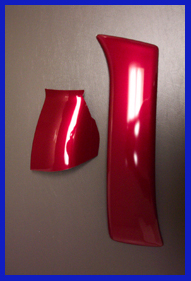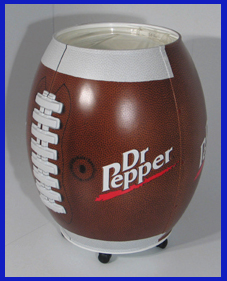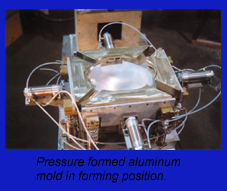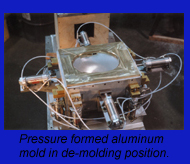|
THERMOFORMING: Emerging Markets in Thermoforming
The cut sheet thermoforming market is improving
rapidly. Many new markets are being created and
applications that were not possible or feasible in
the past are now being innovated, offered and in some
cases demanded!
These improvements and new markets are being driven
by several recent advancements in material, material processing,
more advanced thermoforming equipment, more
elaborate tooling and of course our industry’s ever growing
creativity and determination.
As new applications are discovered and implemented it
is difficult for every thermoformer to be aware of all the
technical advancements. Manufactures must continually
learn from different markets and utilize or apply new technologies.
As the market appears to be running at full
speed we will briefly explore some of the newer markets
or developing markets in the current generation of thermoforming
technology.
Paint Films & Decorative Films
Paint films and decorative films continue to gain rapid
recognition in the marketplace. The thermoformed product
starts with a sheet that is produced by laminating or
co-extruding a paint or decorative film onto a heavier
gauge sheet (ABS, TPO, Polycarbonate, etc.).
 These films
are eliminating the need for painting and/or decorating,
as well as creating new opportunities to replace more
expensive materials or processes.
These films
are eliminating the need for painting and/or decorating,
as well as creating new opportunities to replace more
expensive materials or processes.
Wood grain, stainless steel, aluminum, carbon fiber and
even chrome finished laminates are allowing thermoformers
to manufacture products
that have the features and
benefits of plastic, but still
maintain the same appearance
as the material they are
replacing. Laminated wood
grain materials are being
used where wood appearances
are required, from
automotive interior trim to
hot tub or spa cabinetry.
Stainless steel and aluminum
laminates are replacing high
cost metal products in automotive
as well as in the appliance
enclosure industry. Chrome laminates are replacing
heavier, chromed metal products like vehicle bumpers,
grills and emblems.
What we refer to as paint films, are films and resins that
have been able to achieve a “Class A” automotive quality
finish. Meaning processors can eliminate the need to
paint products after they are formed. Most popular in
automotive exterior parts in the low to mid volume vehicles,
these materials offer huge savings when compared to
the costs of other processes that require establishing an
entire painting process. As the paint films continue to gain
popularity in automotive, these films will also start to find
their way into other market places that require similar
high quality, paint-like finishes.
Foams
From new thermoplastic foam sheet and pre-shaped
rigid foam inserts, to secondary liquid foam, thermoformers
and foam suppliers are continually developing innovative
ways to incorporate foam based materials with thermoformed
parts. Although foams have been used for quite
some time in the thermoforming process, new foam materials
and new foam innovations and applications are pushing
thermoformed product uses to new heights.

New advances in foam sheet materials are allowing
thermoformers to expand their capabilities. Foams are
being used for comfort in shoe insoles, for sound absorption
in interior vehicle applications, as well as for lighter
weight and even moisture resistant reasons (like used in
automotive ventilation systems). Products that must be
light weight, soft and have little rigidity requirements all
lend themselves to thermoforming foam based sheet.
When rigidity is a key factor, twin sheet forming is allowing
processors the ability to insert pre-shaped rigid foam
in between two formed cavities allowing for a stronger
more secure product. Floatation devices, plastic pallets
and doors are all being made utilizing this process. In
many cases the foam allows the end product to be made
with thinner sheet gauges by allowing the foam to act as
the major structure and reinforcement, rather than the
thickness of the plastic sheet. It can also help reduce the
finished products weight when utilizing foams rather than
thicker sheets or other fillers.
In single sheet forming and pressure forming,
different types of pre-shaped rigid foam inserts are
also being used for product reinforcement. Since
we are not inserting foam between two sheets but
rather just to one side, pressure is being utilized to
adhere the pre-shaped rigid foam to the thermoformed
part just subsequent to vacuum forming.
This technology is allowing manufacturers to eliminate
the costly secondary foam operations as well
as any type of gluing operation.
Substrate Forming/Vinyl Wrapping
The automotive interior market is by far the
biggest consumer of these products, but with the
ever changing demands in automotive, a lot of new
opportunities are being created with this technology
in and out of the automotive world.
Substrate forming or vinyl wrapping consists of
heating vinyl and forming it over a pre-glued (heat
activated) rigid substrate. Once vacuum formed the
hot vinyl sheet activates the glue and adheres to the
substrate. The substrate can be made from a variety
of different materials and or processes but typically
depends on the volume. Lower volume substrates
can be a rigid thermoformed part, or even
fiberglass, whereas in most automotive applications
higher volume substrates are injection molded.
As these applications make their way into the
contract manufacturers’ facilites we are beginning
to see this same technology starting to be
applied outside of the automotive interior market.
All mass transportation methods can utilize
this technology; buses, trucks, RVs and trains,
the soft touch leather-like appearances add a
higher quality part making final products more
attractive and appear higher end looking. In
addition to transportation markets, this technology
is replacing many other leather wrapping
applications, like seat coverings, armrests and
even custom carrying cases.
With these opportunities, new manufacturers
and new suppliers are working together to develop
new methods and improvements to accommodate
better processing methods.
Screen Printing/Distortion Printing
Screen printing or distortion printing onto raw sheet
stock, then thermoforming it into a 3-D product, has been
somewhat of a niche market in thermoforming. New technology
is allowing more companies to expand their offerings
into this area. Most popular in the display, sign and
point-of-purchase industry, screen printing sheet and
forming it has traditionally taken an extensive knowledge
of both processes to be efficient and profitable. This
knowledge was derived from experience and trial and
error.
Today, new companies or inexperienced thermoformers
can easily and quickly take on these projects thanks
to new proprietary software and processing developments.
Thermoformers are now able to create
these products by utilizing virtually the same standard
job procedures they traditionally use. Once
the part is designed and molds have been made,
the thermoformer only has to run a few sheets with
grids on them and record their machine settings (so
they can run production using these same settings).
The now formed blank sheets can be digitized and
processed through custom software which will determine
the proper distortion printing parameters.
Once printed,
manufacturers
can set up
the machine
as they did
for the sample
run and
create a
quality part
on the first
shot, therefore
eliminating
the learning
curves as
well as the
entire trial and error process typically associated
with the graphic printing. This new software basically
turns a difficult, time consuming distortion
thermoformed project, into a straightforward
affordable vacuum formed part.
Larger Parts
Large part thermoforming is nothing new but
manufacturers and OEMs are gaining confidence
and are proceeding to replace many large products
that have previously been made in more expensive,
slower and more labor intensive processes.
In the past, low volume requirements have made
it too costly to thermoform some large products.
Today some OEMs and end users are finding ways
to increase volumes not only through increasing
sales but by standardizing some of these larger
products. By standardizing, manufacturers can justify the
costs associated with large part thermoforming and maintain
much more consistency and repeatability.
Large fiberglass products are steadily being converted
over to thermoforming; from boat hulls, to large bus,
truck, tractor and RV parts. Water drainage systems, holding
tanks and other products related to new construction
business are also gaining popularity and are being produced
in larger volumes. With more and more companies
investing in large machinery capable of forming these
products, new applications and new markets will continue
to develop even further.
Pressure Forming &
Twin Sheet Forming
Pressure Forming and Twin Sheet Forming continue
to gain popularity and are becoming much more
recognized. Consumers are demanding better aesthetics
and more design features in their products
that the traditional thermoforming process cannot
offer.
 Many thermoforming manufacturers are quickly
adapting to have true pressure and twin sheet
capabilities by either purchasing new machinery
along with its new technology or by establishing relationships
with other companies who already have
these capabilities.
Many thermoforming manufacturers are quickly
adapting to have true pressure and twin sheet
capabilities by either purchasing new machinery
along with its new technology or by establishing relationships
with other companies who already have
these capabilities.
As this technology matures throughout the industry,
manufacturers are becoming more aware of what
these two processes can add to their current product
offerings. Even companies who have had these capabilities
are learning more from their machine and
mold manufacturers on how far these processes can
be taken. As new applications develop, new technology
will continue to develop with it. Never before have
we seen such creativity in mold designs.
 Molds with
moving pieces, undercuts, flippers and hinges are
becoming somewhat common, rather than specialty
projects. Today’s pressure forming market has room
to grow, and mold design and capabilities will continue
pushing out better products more efficiently.
“Pressure formed aluminum mold in forming position”
“Pressure formed aluminum mold in de-molding position”
Molds with
moving pieces, undercuts, flippers and hinges are
becoming somewhat common, rather than specialty
projects. Today’s pressure forming market has room
to grow, and mold design and capabilities will continue
pushing out better products more efficiently.
“Pressure formed aluminum mold in forming position”
“Pressure formed aluminum mold in de-molding position”
These applications and new markets are all being driven
by the improvements our industry is making in materials
and machinery. They stem from a combination of straight
creativity, finding solutions to product sophistications and
the customer demanding more for less. From reducing costs
and adding strength and longevity, to increased functionality,
today’s thermoformers will continue to develop new applications
for replacing wood, metal, fiberglass, glass or just
replacing other plastic processes. Today’s thermoformers
are proving the processes wide range and flexibility.
Consumer confidence is increasing and the new advances
being made are opening more doors to today’s thermoformers
and their customers.
Written by Michael P. Alongi, Sales Director for MAAC
Machinery Corp., manufacturers of a wide range of cutsheet
thermoforming machinery.
For more information, contact MAAC Machinery
Corp., 590 Tower Blvd., Carol Stream, IL 60188, 630-665-
1700, Fax: 630-665-7799, E-mail: sales@maacmachinery
.com, Web: www.maacmachinery.com.
|